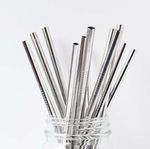Bye-bye, plastic straws - Bund.de
←
→
Page content transcription
If your browser does not render page correctly, please read the page content below
SAFETY OF PRODUCTS AND CHEMICALS
Bye-bye,
plastic straws
From July 2021, straws will be a disposable plastic product that
can no longer be sold in the EU. There are plenty of alternatives
that can be used as food contact materials and, therefore,
also for straws.
A
picnic in the park without plastic utensils, before initial use and also every time between uses. If
cocktails at the bar without a plastic straw – this possible, use a thin glass brush under warm, running
has been determined in the “EU Directive on the water or wash in the dishwasher at 60 degrees Celsius. If
reduction of the impact of certain plastic products on the thorough cleaning of the straws is not possible, the BfR
environment”. Germany has already implemented this recommends that multiple-use straws are not used for
directive into national law, with effect from 1 July 2021. reasons of hygiene. Furthermore, straws should not have
In doing so, frequently used everyday products, such as any sharp edges and should also be replaced if there are
straws, which until now have been predominantly made initial signs of material damage (signs of wear and tear).
of plastic, will have to be made from other materials.
BfR2GO presents the most important alternatives to
Metal, paper, glass, etc. – what should consumers look plastic straws at home.
out for? First things first: regardless of the material,
straws used repeatedly must be thoroughly cleaned
© PENpics Studio/shutterstock.com
“Straw straws”
Straws made of straw as an alternative? An obvious
option. However, the natural material may contain
invisible germs, mycotoxins, such as deoxynivalenol
(DON), or other undesirable substances, such as
residues from plant protection products. These could
enter the body when drinking and make you ill.
28 BfR 2 GOPLASTIC ALTERNATIVES
© CarlosDavid/shutterstock.com
Paper straws
Paper straws can also be a suitable disposable alter-
native to plastic straws. To make sure that they remain
robust and do not immediately become soft in the
drink, epichlorohydrin-based resins are often added
to them during the manufacturing process. These
resins can release potentially harmful substances into
the drink, such as chloropropanol. For this reason,
companies should follow BfR recommendations for the
manufacturing process – then there will be no health
risks when enjoying your favourite drink with a paper
straw.
© MichellePatrickPhotographyLLC/iStockphoto
ws
Stainless steel stra
This material is a very suitable alternative to plastic.
It can be reused as often as required, does not
rust and can be used for both cold and hot drinks.
Stainless-steel straws should be cleaned after each
use, for example, with a brush or in the dishwasher.
The Council of Europe’s requirements for metals
and alloys are important for manufacturers of this
kind of straw. They determine maximum limits for
the release of chemical elements, including 21
metals such as nickel, chromium and lead. The aim
of the requirements is to release as few undesirable
substances as possible.
02/2020 29SAFETY OF PRODUCTS AND CHEMICALS
© Studio GOOD
Macaroni
or similar pasta
If a straw is only used once, then there is no
argument against the use of durum wheat (e.g. raw
macaroni pasta) from a health perspective. Only
industrially produced noodles that do not contain egg
as an ingredient should be used. The extent to which
this tastes good or whether the pasta becomes soft
in hot drinks and then makes the drink taste a bit like
pasta is something you have to decide for yourself.
© triocean/shutterstock.com
Bamboo straws
Uncoated straws made of bamboo are a natural
material just like straws made of straw. An advantage
of bamboo is its stability. In comparison to straw, it is
significantly more durable and can be used several
times. However, special attention must be given to
cleaning since bamboo drinking straws have a rougher
surface than glass or stainless-steel straws, for exam-
ple. Germs can stick to it and enter the body unseen
when drinking.
30 BfR 2 GOPLASTIC ALTERNATIVES
© Pooh Yuphayao/shutterstock.com
Silicone straws
This soft material is a suitable for food contact.
However, silicone straws should be thoroughly cleaned
after each use. It is best to use a thin cleaning brush
or similar. This is important so that no germs stick to
the inside of the straw, which you would then drink
the next time you use it. Manufacturers should follow
BfR recommendations for silicone as a food contact
material. Specifically: at the end of production in par-
ticular, heat the straws up to a high temperature once
to remove volatile substances before the products are
put on the market.
© VDB Photos/shutterstock.com
Glass straws
Watch the liquid go up the straw when drinking – this
is possible with glass straws. The material has been
used in the food sector for many centuries without any
problems. Glass straws are reusable because they
are easy to clean. You can see if they are clean on the
inside. The disadvantage: glass is fragile and there
can be sharp-edged fragments. This is why glass
straws are not suitable, especially for small children.
However, you can now get shatterproof glass. ◘
More information:
www.bfr.bund.de > Press > Mediathek (in German)
02/2020 31You can also read
























































